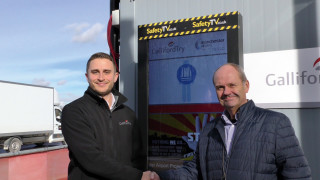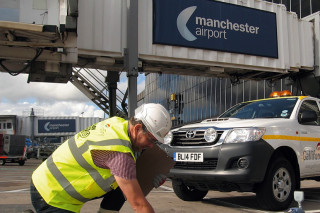Health & safety signage has become a familiar feature of all but the smallest construction sites and signs tend to follow a familiar pattern. It’s easy to get used to them and once that happens, it’s easy to ignore them.
Much better, then, to put the messages on TV. Anomaly Hi-Vis is one of a handful of companies that specialise in outdoor, site-specific signage projected onto digital screens that can be regularly updated remotely or even broadcast a playlist of scheduled content tailored to the site and the audience.
Digital noticeboards and television screens are nothing new. “We’ve been doing it for donkey’s years,” admits Anomaly Hi-Vis managing director Phil Austin. But he says the construction application is still relatively new.
One of the first applications was in schools, where instead of pinning pieces of paper to a corkboards to be ignored by the unruly horde, school staff could harness the addictive qualities of flat-screen TV and actually grab students’ attention.
And even before that, in 2004, Austin helped launch Tesco TV, the in-house television channel that was beamed out to the retailer’s 100 largest stores around the country.
Tesco TV didn’t last – the supermarket chain pulled the plug just five years later. But by then the noticeboard application had proved a success in schools and Anomaly Hi-Vis started to grow the market.
The schools market has plateaued and now “has a life of its own,” says Austin. “British construction is now our largest growth market by far.”

The idea of using this technology in a construction context came three and a half years ago from an acquaintance of Austin’s, John Morewood, who at the time was a site manager with contractor Willmott Dixon. “He took one look at it and said ‘you should put those on construction sites’,” says Austin.
The company currently has something in the order of 4,000 display units out in the field with several tier one contractors and a number of leading house-builders among its customers.
The latest contract, and one of the firm’s biggest to date, is with Galliford Try which has chosen Anomaly Hi-Vis as its health & safety signage provider on the £1bn Manchester Airport expansion project.
The Hi-Vis system enables instantaneous site updates throughout the Manchester Airport site, displaying information on large-format external screens strategically positioned to obtain maximum exposure to construction workers and visitors alike.
The screens are specially designed for the application. They are very bright, ensuring that they can be read easily even in bright sunlight, and are supplied in a robust IP55-rated enclosure. “The kit is very, very robust – it’s not just a domestic TV in a waterproof box,” says Austin. And despite the brightness, each unit is rated at only 200W.
The display units, the software and the content are all provided by Anomaly Hi-Vis, says Austin.
“We install the unit and put the core health & safety information on there. But we can tailor the display to the client’s needs,” he says. Site-specific information is gathered from the client, which also adds news and special notices as and when required.
According to Austin, Anomaly Hi-Vis has a library of several thousand unique pieces of information, none of it supplied by third parties. Real-time data can be provided via an RSS news feed. “All the information is hosted on the cloud. We can include real-time weather updates including wind alerts which is important for tower crane operations,” Austin explains.

“We can display it in various formats, including split-screen if the client wants and weather and news can be displayed on a ‘ticker’.
“Screens can be updated, with new messages, video footage or company information from a smartphone or PC. All they need is standard internet access. There are hundreds of video and message templates on our online portal, all tailored to the clients branding,” says Austin.
Despite the ease with which information can be altered, Austin says he has never seen a single case of the system being abused. In construction applications it is usually the contractor’s health & safety manager or site manager who has control of the system.
James MacDonald, aviation assurance manager at Galliford Try, says the system has proved to be an effective way of communicating key health and safety information to the contractor’s workforce, supply-chain, visitors and members of the public.
“They have become pivotal in raising health and safety awareness and sharing best practice, project updates and general company information both quickly and easily,” he says.
“We’re able to customise each screen depending on the target audience and this allows for relevant, eye-catching and memorable information to be shared. From a health, safety and environmental perspective, this is crucial in communicating and raising awareness of hazards.”
He adds: “We’ve installed numerous Anomaly screens across the Galliford Try aviation business and the feedback so far has been incredibly positive. We now plan to explore what other business units will benefit from this technology.”
Manchester Airport expansion
In December 2017 Galliford Try secured a £54m contract for the second phase of the £1bn, 10-year, Manchester Airport Transformation Programme (MANTP). This project will double the size of Terminal 2 and reconfigure its airfield to unlock the growth potential of its two runways.
This second contract follows on from the award of a £38m contract on the scheme’s first phase, the extension to the airfield’s west apron, including taxiways and aircraft stands.
The current phase will increase aircraft stand capacity and other aircraft parking to cope with 2024 traffic projections, maximise the use of both runways by upgrading the existing taxiway system and improve departure performance capability.
The Galliford Try team will install more than 79,000m3 of pavement-quality concrete for new taxiways and aircraft stands while reallocating the existing airfield and dualling a mile-long, 400,000m2 stretch of taxiway so that aircraft can be manoeuvred more efficiently.
In addition, more than six miles of new ducting and lighting will be installed and the existing security boundary relocated to accommodate the changes.
Galliford Try is working alongside Laing O’Rourke, which is delivering a £570m package of works over the project’s 10-year duration. This includes the design and construction of the Terminal 2 building extension as well as a new 3,800-space multi-storey car park, significant upgrades to the airport’s landscaping and road infrastructure, as well the initial two new piers for arrivals and departures.
This article was first published in the April 2019 issue of The Construction Index magazine
UK readers can have their own copy of the magazine, in real paper, posted through their letterbox each month by taking out an annual subscription for just £50 a year. Click for details.
Got a story? Email news@theconstructionindex.co.uk



